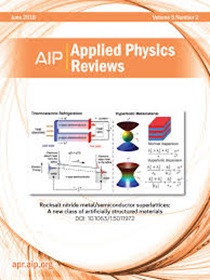通过有效的剪切应变,在宽温度范围内解锁高孔洞迁移率
IF 11.9
1区 物理与天体物理
Q1 PHYSICS, APPLIED
引用次数: 0
摘要
作为一种宽禁带半导体,金刚石具有优异的电学和热性能,在电子工业中具有很高的应用前景。然而,它的井眼迁移率相对较低,并且随着温度的升高而急剧下降,这严重限制了其进一步的应用。在此,我们提出沿[100]方向的轻微压缩剪切应变可以有效地提高孔迁移率,而沿[111]方向的剪切应变的改善是边际的。这种令人印象深刻的区别归因于变形势和弹性顺应矩阵。剪切应变破坏了晶体结构的对称性,提高了价带边缘附近的能带简并,从而显著抑制了带间电子-声子散射。此外,由于高频声子的电子散射减少,空穴迁移率变得不那么依赖于温度。值得注意的是,在800 K下,沿[100]方向施加2%的压缩剪切应变,金刚石的面内孔迁移率提高了~ 800%。有效的剪切应变策略可以进一步推广到其他面心立方几何的半导体。本文章由计算机程序翻译,如有差异,请以英文原文为准。
Unlocking high hole mobility in diamond over a wide temperature range via efficient shear strain
As a wide bandgap semiconductor, diamond holds both excellent electrical and thermal properties, making it highly promising in the electrical industry. However, its hole mobility is relatively low and dramatically decreases with increasing temperature, which severely limits further applications. Herein, we proposed that the hole mobility can be efficiently enhanced via slight compressive shear strain along the [100] direction, while the improvement via shear strain along the [111] direction is marginal. This impressive distinction is attributed to the deformation potential and the elastic compliance matrix. The shear strain breaks the symmetry of the crystalline structure and lifts the band degeneracy near the valence band edge, resulting in a significant suppression of interband electron–phonon scattering. Moreover, the hole mobility becomes less temperature-dependent due to the decrease of electron scatterings from high-frequency acoustic phonons. Remarkably, the in-plane hole mobility of diamond is increased by ∼800% at 800 K with a 2% compressive shear strain along the [100] direction. The efficient shear strain strategy can be further extended to other semiconductors with face-centered cubic geometry.
求助全文
通过发布文献求助,成功后即可免费获取论文全文。
去求助
来源期刊

Applied physics reviews
PHYSICS, APPLIED-
CiteScore
22.50
自引率
2.00%
发文量
113
审稿时长
2 months
期刊介绍:
Applied Physics Reviews (APR) is a journal featuring articles on critical topics in experimental or theoretical research in applied physics and applications of physics to other scientific and engineering branches. The publication includes two main types of articles:
Original Research: These articles report on high-quality, novel research studies that are of significant interest to the applied physics community.
Reviews: Review articles in APR can either be authoritative and comprehensive assessments of established areas of applied physics or short, timely reviews of recent advances in established fields or emerging areas of applied physics.
 求助内容:
求助内容: 应助结果提醒方式:
应助结果提醒方式:


